
Franco-American alliance
Encyclopedia
The Franco-American alliance refers to the 1778 alliance between Louis XVI's France
and the United States
, during the American Revolutionary War
. Formalized in the 1778 Treaty of Alliance
, it was a military pact in which France provided arms and money, and engaged in full-scale war with Britain
. The Netherlands
and Spain
later joined as allies of France; Britain had no allies. The French alliance was possible once the Americans captured a British invasion army at Saratoga
in October 1777, demonstrating the viability of the American cause. The alliance became controversial after 1793 when Britain and France again went to war and the U.S. declared itself neutral. Relations between France and the U.S. worsened as the U.S. moved closer to Britain in the Jay Treaty
of 1795, leading to an undeclared Quasi War. The alliance was defunct by 1794 and formally ended in 1800.
which they feared gave the British naval hegemony
. From 1763 both France, and their allies Spain
, began to rebuild their navies and prepare for a future war in which they would construct an alliance to overwhelm and invade Britain. As Britain's troubles with its American colonies intensified during the 1760s and eventually led to open rebellion in 1775 - France began to anticipate the American rebels joining such an alliance.
In September 1775 the Continental Congress
described foreign assistance as "undoubtedly attainable" and began to seek supplies and assistance from European powers hostile to Britain. The French leadership sought the "humiliation of England" and began giving covert aid to the rebels. The American declaration of independence
was advocated by some as necessary in order to secure European support against Britain. Silas Deane
, an American envoy in Paris, proposed a major anti-British alliance and French invasions of Hanover
and Portugal
which were both British allies.
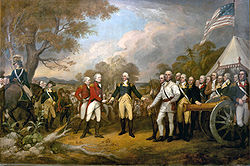
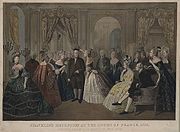
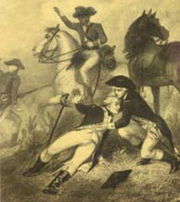 The alliance was promoted in the United States by Thomas Jefferson
The alliance was promoted in the United States by Thomas Jefferson
, a Francophile
. Based on the Model Treaty
of 1776, Jefferson encouraged the role of France as an economic and military partner to the United States, in order to weaken British influence.
In 1776, Latouche Tréville
transferred ammunition from France to the United States of America. Numerous French supplies as well as guns of the de Valliere
type were used in the American War of Independence, especially the smaller 4-pounder field guns. The guns were shipped from France
, and the field carriages provided for in the US. These guns played an important role in such battles as the Battle of Saratoga, and the Siege of Yorktown
. George Washington
wrote about the supplies and guns in a letter to General Heath
on 2 May 1777:
On 13 June 1777, the Marquis de Lafayette reached America and joined George Washington
in the Continental Army
as Major General
. He participated to the Battle of Brandywine
where he was wounded, and later served at the Battle of Rhode Island
. Lafayette would later return to France during the war in order to advocate more support for the American cause.
and the 1778 Treaty of Alliance
was signed on February 6, 1778 after the American victory at the Battle of Saratoga
, under the designation of "Franco-American Treaty of Amity and Commerce". The treaty gave open support from the French Army, Navy and Treasury, and spelled that the United States
was obligated to guaranty "from the present time and forever, against all other powers (...) the present Possessions of the Crown of France in America", in exchange for a promise not to increase French possessions anymore in America.
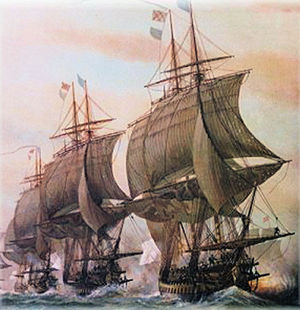
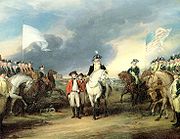 The combined strength of the Americans and the French virtually guaranteed victory against Great Britain. France successfully supported the American War of Independence, managing to expel the British and obtain recognition of American independence through the intervention of Rochambeau
The combined strength of the Americans and the French virtually guaranteed victory against Great Britain. France successfully supported the American War of Independence, managing to expel the British and obtain recognition of American independence through the intervention of Rochambeau
, La Fayette
, de Grasse
, or Suffren
.
in July 1778, and continued with the attempted invasion of Britain with the Armada of 1779
.
arrived with a fleet and infantry reinforcements for the war with a fleet of twelve ships of the line
and fourteen frigate
s. After declining to attack Richard Howe's inferior British force outside New York, the French fleet sailed to Rhode Island
where they were to take part in an attack on Newport
.
On 6 July 1779, he successfully fought the Battle of Grenada
against Admiral Byron
, but failed at the September 1779 Siege of Savannah
before returning to France. Actions continued in April 1780 with Guichen
against Admiral Rodney
in the Battle of Martinique
.
 In 1780, Rochambeau arrived with a fleet and 6,000 French troops to join the Continental army
In 1780, Rochambeau arrived with a fleet and 6,000 French troops to join the Continental army
, under George Washington
, in the "Expédition Particulière
", landing in Newport, Rhode Island
, on 10 July. In the Ohio valley, French Americans would also combine with Indian troops, as in the Battle of Kekionga
in 1780 under Augustin de La Balme
.
The French Navy
played a decisive role in supporting the American side, as American forces could hardly resist the powerful British Navy. The French under de Grasse managed to defeat a British fleet at the Battle of the Chesapeake
in 1781, thus ensuring that the Franco-American ground forces would win the ongoing Siege of Yorktown
, the last major land battle of the Revolutionary War. The British surrendered to American and French forces at Yorktown in 1781.
France continued to fight against the British in the 1782 Antilles War
.
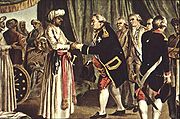 France further supported the war effort against Great Britain by attacking British possessions in India
France further supported the war effort against Great Britain by attacking British possessions in India
. In 1782, Louis XVI sealed an alliance
with the Peshwa
Madhu Rao Narayan
. Suffren
became the ally of Hyder Ali
in the Second Anglo-Mysore War
against British rule in India, in 1782-1783, fighting the British fleet on the coasts of India and Ceylon.
Between February 1782 until June 1783, Suffren fought the English admiral Sir Edward Hughes, and collaborated with the rulers of Mysore. Suffren
fought in the Battle of Sadras
on February 17, 1782, the Battle of Providien
on April 12 near Trincomalee
, the Battle of Negapatam (1782)
on July 6 off Cuddalore
, after which Suffren seized upon the anchorage of Trincomalee compelling the small British garrison to surrender. An army of 3,000 French soldiers collaborated with Hyder Ali to capture Cuddalore
. Finally the Battle of Trincomalee
took place near that port on September 3. These battles can be seen as the last battles of the Franco-British conflict that encompassed the American War of Independence, and would cease in 1783 with the signature of the 1783 peace treaty.
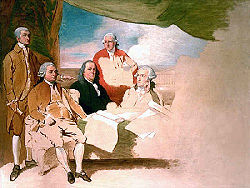 Finally, the Treaty of Paris
Finally, the Treaty of Paris
was signed on 3 September 1783, recognizing American independence and the end of hostilities.
The 1778 Treaty of Alliance, promising the defense of French territory in the American continent, failed to be observed by the United States
as soon as 1793, when France entered in conflict with Great Britain in the Caribbean
. All the U.S. could do was maintain neutrality, but this neutrality was so negative as to forbid the French the right to equip and arm privateers in American ports, or the right to dispose of French prizes in the United States. These reluctances in effect marked the end of the alliance.
 As the United States entered into a treaty of commerce with Great Britain in 1794, France started to raid American shipping, seizing 316 ships in 1796. In 1796, the disillusioned Minister Pierre Adet
As the United States entered into a treaty of commerce with Great Britain in 1794, France started to raid American shipping, seizing 316 ships in 1796. In 1796, the disillusioned Minister Pierre Adet
explained: "Jefferson (...) is American, and as such, he cannot sincerely be our friend. An American is the born enemy of all the European peoples", and in 1798, the XYZ Affair
considerably worsened Franco-American relations.
The events led to the Quasi-War
(1798–1800) between France and the United States, with actual naval encounters taking place between the two powers, with the encounter between USS Constellation
and French ship L'Insurgente
on 9 February 1799 off Nevis Island, and USS Constellation and La Vengeance
in February 1800 off Guadeloupe
. An agreement followed, in which the United States agreed to pay 20 million dollars in compensation, and France agreed to give up its claims to the 1778 Treaty.
Britain would also attempt to interfere with American trade and shipping, starting with the Orders in Council in 1807, which forbade trade with France by Britain, her allies, and any neutral nation , which meant the United States. The US protested that this act was illegal under international law, and this act was a contributory factor to the enmity between the US and Britain which caused the War of 1812
.
Early Modern France
Kingdom of France is the early modern period of French history from the end of the 15th century to the end of the 18th century...
and the United States
United States
The United States of America is a federal constitutional republic comprising fifty states and a federal district...
, during the American Revolutionary War
American Revolutionary War
The American Revolutionary War , the American War of Independence, or simply the Revolutionary War, began as a war between the Kingdom of Great Britain and thirteen British colonies in North America, and ended in a global war between several European great powers.The war was the result of the...
. Formalized in the 1778 Treaty of Alliance
Treaty of Alliance (1778)
The Treaty of Alliance, also called The Treaty of Alliance with France, was a defensive alliance between France and the United States of America, formed in the midst of the American Revolutionary War, which promised military support in case of attack by British forces indefinitely into the future...
, it was a military pact in which France provided arms and money, and engaged in full-scale war with Britain
Kingdom of Great Britain
The former Kingdom of Great Britain, sometimes described as the 'United Kingdom of Great Britain', That the Two Kingdoms of Scotland and England, shall upon the 1st May next ensuing the date hereof, and forever after, be United into One Kingdom by the Name of GREAT BRITAIN. was a sovereign...
. The Netherlands
Dutch Empire
The Dutch Empire consisted of the overseas territories controlled by the Dutch Republic and later, the modern Netherlands from the 17th to the 20th century. The Dutch followed Portugal and Spain in establishing an overseas colonial empire, but based on military conquest of already-existing...
and Spain
Spanish Empire
The Spanish Empire comprised territories and colonies administered directly by Spain in Europe, in America, Africa, Asia and Oceania. It originated during the Age of Exploration and was therefore one of the first global empires. At the time of Habsburgs, Spain reached the peak of its world power....
later joined as allies of France; Britain had no allies. The French alliance was possible once the Americans captured a British invasion army at Saratoga
Saratoga campaign
The Saratoga Campaign was an attempt by Great Britain to gain military control of the strategically important Hudson River valley in 1777 during the American Revolutionary War...
in October 1777, demonstrating the viability of the American cause. The alliance became controversial after 1793 when Britain and France again went to war and the U.S. declared itself neutral. Relations between France and the U.S. worsened as the U.S. moved closer to Britain in the Jay Treaty
Jay Treaty
Jay's Treaty, , also known as Jay's Treaty, The British Treaty, and the Treaty of London of 1794, was a treaty between the United States and Great Britain that is credited with averting war,, resolving issues remaining since the Treaty of Paris of 1783, which ended the American Revolution,, and...
of 1795, leading to an undeclared Quasi War. The alliance was defunct by 1794 and formally ended in 1800.
Background
France had been left deeply alarmed by the British success in the Seven Years WarGreat Britain in the Seven Years War
The Kingdom of Great Britain was one of the major participants in the Seven Years' War which lasted between 1756 and 1763. Britain emerged from the war as the world's leading colonial power having gained a number of new territories at the Treaty of Paris in 1763 and established itself as the...
which they feared gave the British naval hegemony
Hegemony
Hegemony is an indirect form of imperial dominance in which the hegemon rules sub-ordinate states by the implied means of power rather than direct military force. In Ancient Greece , hegemony denoted the politico–military dominance of a city-state over other city-states...
. From 1763 both France, and their allies Spain
Spain
Spain , officially the Kingdom of Spain languages]] under the European Charter for Regional or Minority Languages. In each of these, Spain's official name is as follows:;;;;;;), is a country and member state of the European Union located in southwestern Europe on the Iberian Peninsula...
, began to rebuild their navies and prepare for a future war in which they would construct an alliance to overwhelm and invade Britain. As Britain's troubles with its American colonies intensified during the 1760s and eventually led to open rebellion in 1775 - France began to anticipate the American rebels joining such an alliance.
In September 1775 the Continental Congress
Continental Congress
The Continental Congress was a convention of delegates called together from the Thirteen Colonies that became the governing body of the United States during the American Revolution....
described foreign assistance as "undoubtedly attainable" and began to seek supplies and assistance from European powers hostile to Britain. The French leadership sought the "humiliation of England" and began giving covert aid to the rebels. The American declaration of independence
United States Declaration of Independence
The Declaration of Independence was a statement adopted by the Continental Congress on July 4, 1776, which announced that the thirteen American colonies then at war with Great Britain regarded themselves as independent states, and no longer a part of the British Empire. John Adams put forth a...
was advocated by some as necessary in order to secure European support against Britain. Silas Deane
Silas Deane
Silas Deane was an American merchant, politician and diplomat. Originally a supporter of American independence Deane served as a delegate to the Continental Congress and then as the United States' first foreign diplomat when he travelled to France to lobby the French government for aid...
, an American envoy in Paris, proposed a major anti-British alliance and French invasions of Hanover
Electorate of Hanover
The Electorate of Brunswick-Lüneburg was the ninth Electorate of the Holy Roman Empire of the German Nation...
and Portugal
Portugal
Portugal , officially the Portuguese Republic is a country situated in southwestern Europe on the Iberian Peninsula. Portugal is the westernmost country of Europe, and is bordered by the Atlantic Ocean to the West and South and by Spain to the North and East. The Atlantic archipelagos of the...
which were both British allies.



Thomas Jefferson
Thomas Jefferson was the principal author of the United States Declaration of Independence and the Statute of Virginia for Religious Freedom , the third President of the United States and founder of the University of Virginia...
, a Francophile
Francophile
Is a person with a positive predisposition or interest toward the government, culture, history, or people of France. This could include France itself and its history, the French language, French cuisine, literature, etc...
. Based on the Model Treaty
Model Treaty
The Model Treaty, or the Plan of 1776, was created during the American Revolution and was an idealistic guide for foreign relations and future treaties between the new American government and other nations.-Creation:...
of 1776, Jefferson encouraged the role of France as an economic and military partner to the United States, in order to weaken British influence.
In 1776, Latouche Tréville
Louis-René Levassor de Latouche Tréville
Louis-René Levassor de Latouche Tréville was a French admiral and a hero of the American Revolutionary War and of the Napoleonic wars.-Early life:...
transferred ammunition from France to the United States of America. Numerous French supplies as well as guns of the de Valliere
Florent-Jean de Vallière
Florent-Jean de Vallière was a French artillery officer of the 18th century. He was lieutenant-general of the King's Armies. In 1726, de Vallière became Director-General of the Battalions and Schools of the Artillery....
type were used in the American War of Independence, especially the smaller 4-pounder field guns. The guns were shipped from France
France
The French Republic , The French Republic , The French Republic , (commonly known as France , is a unitary semi-presidential republic in Western Europe with several overseas territories and islands located on other continents and in the Indian, Pacific, and Atlantic oceans. Metropolitan France...
, and the field carriages provided for in the US. These guns played an important role in such battles as the Battle of Saratoga, and the Siege of Yorktown
Siege of Yorktown
The Siege of Yorktown, Battle of Yorktown, or Surrender of Yorktown in 1781 was a decisive victory by a combined assault of American forces led by General George Washington and French forces led by the Comte de Rochambeau over a British Army commanded by Lieutenant General Lord Cornwallis...
. George Washington
George Washington
George Washington was the dominant military and political leader of the new United States of America from 1775 to 1799. He led the American victory over Great Britain in the American Revolutionary War as commander-in-chief of the Continental Army from 1775 to 1783, and presided over the writing of...
wrote about the supplies and guns in a letter to General Heath
Heath
-Habitats:* Heath or heathland, low-growing woody vegetation, mostly consisting of heathers and related species* Heaths in the British National Vegetation Classification system...
on 2 May 1777:
On 13 June 1777, the Marquis de Lafayette reached America and joined George Washington
George Washington
George Washington was the dominant military and political leader of the new United States of America from 1775 to 1799. He led the American victory over Great Britain in the American Revolutionary War as commander-in-chief of the Continental Army from 1775 to 1783, and presided over the writing of...
in the Continental Army
Continental Army
The Continental Army was formed after the outbreak of the American Revolutionary War by the colonies that became the United States of America. Established by a resolution of the Continental Congress on June 14, 1775, it was created to coordinate the military efforts of the Thirteen Colonies in...
as Major General
Major General
Major general or major-general is a military rank used in many countries. It is derived from the older rank of sergeant major general. A major general is a high-ranking officer, normally subordinate to the rank of lieutenant general and senior to the ranks of brigadier and brigadier general...
. He participated to the Battle of Brandywine
Battle of Brandywine
The Battle of Brandywine, also known as the Battle of the Brandywine or the Battle of Brandywine Creek, was fought between the American army of Major General George Washington and the British-Hessian army of General Sir William Howe on September 11, 1777. The British defeated the Americans and...
where he was wounded, and later served at the Battle of Rhode Island
Battle of Rhode Island
The Battle of Rhode Island, also known as the Battle of Quaker Hill and the Siege of Newport, took place on August 29, 1778. Continental Army and militia forces under the command of General John Sullivan were withdrawing to the northern part of Aquidneck Island after abandoning their siege of...
. Lafayette would later return to France during the war in order to advocate more support for the American cause.
Treaty of Alliance
The alliance was formally negotiated by Benjamin FranklinBenjamin Franklin
Dr. Benjamin Franklin was one of the Founding Fathers of the United States. A noted polymath, Franklin was a leading author, printer, political theorist, politician, postmaster, scientist, musician, inventor, satirist, civic activist, statesman, and diplomat...
and the 1778 Treaty of Alliance
Treaty of Alliance (1778)
The Treaty of Alliance, also called The Treaty of Alliance with France, was a defensive alliance between France and the United States of America, formed in the midst of the American Revolutionary War, which promised military support in case of attack by British forces indefinitely into the future...
was signed on February 6, 1778 after the American victory at the Battle of Saratoga
Battle of Saratoga
The Battles of Saratoga conclusively decided the fate of British General John Burgoyne's army in the American War of Independence and are generally regarded as a turning point in the war. The battles were fought eighteen days apart on the same ground, south of Saratoga, New York...
, under the designation of "Franco-American Treaty of Amity and Commerce". The treaty gave open support from the French Army, Navy and Treasury, and spelled that the United States
United States
The United States of America is a federal constitutional republic comprising fifty states and a federal district...
was obligated to guaranty "from the present time and forever, against all other powers (...) the present Possessions of the Crown of France in America", in exchange for a promise not to increase French possessions anymore in America.
Operations


Jean-Baptiste Donatien de Vimeur, comte de Rochambeau
Marshal of France Jean-Baptiste Donatien de Vimeur, comte de Rochambeau was a French nobleman and general who participated in the American Revolutionary War as the commander-in-chief of the French Expeditionary Force which came to help the American Continental Army...
, La Fayette
Gilbert du Motier, marquis de La Fayette
Marie-Joseph Paul Yves Roch Gilbert du Motier, Marquis de La Fayette , often known as simply Lafayette, was a French aristocrat and military officer born in Chavaniac, in the province of Auvergne in south central France...
, de Grasse
François Joseph Paul de Grasse
Lieutenant Général des Armées Navales François-Joseph Paul, marquis de Grasse Tilly, comte de Grasse was a French admiral. He is best known for his command of the French fleet at the Battle of the Chesapeake, which led directly to the British surrender at Yorktown...
, or Suffren
Pierre André de Suffren de Saint Tropez
Admiral comte Pierre André de Suffren de Saint Tropez, bailli de Suffren , French admiral, was the third son of the marquis de Saint Tropez, head of a family of nobles of Provence which claimed to have emigrated from Lucca in the 14th century...
.
European front
Naval conflict started in European waters with the First Battle of UshantBattle of Ushant (1778)
The Battle of Ushant took place on 27 July 1778, during the American War of Independence, fought between French and British fleets 100 miles west of Ushant, a French island at the mouth of the English Channel off the north-westernmost point of France...
in July 1778, and continued with the attempted invasion of Britain with the Armada of 1779
Armada of 1779
The Armada of 1779 was an exceptionally large joint French and Spanish fleet intended, with the aid of a feint by the American Continental Navy, to facilitate an invasion of Britain, as part of the wider American War of Independence, and in application of the Franco-American alliance...
.
1st American campaign
In the summer of 1778, French Admiral d'EstaingCharles Hector, comte d'Estaing
Jean Baptiste Charles Henri Hector, comte d'Estaing was a French general, and admiral. He began his service as a soldier in the War of the Austrian Succession, briefly spending time as a prisoner of war of the British during the Seven Years' War...
arrived with a fleet and infantry reinforcements for the war with a fleet of twelve ships of the line
Ship of the line
A ship of the line was a type of naval warship constructed from the 17th through the mid-19th century to take part in the naval tactic known as the line of battle, in which two columns of opposing warships would manoeuvre to bring the greatest weight of broadside guns to bear...
and fourteen frigate
Frigate
A frigate is any of several types of warship, the term having been used for ships of various sizes and roles over the last few centuries.In the 17th century, the term was used for any warship built for speed and maneuverability, the description often used being "frigate-built"...
s. After declining to attack Richard Howe's inferior British force outside New York, the French fleet sailed to Rhode Island
Rhode Island
The state of Rhode Island and Providence Plantations, more commonly referred to as Rhode Island , is a state in the New England region of the United States. It is the smallest U.S. state by area...
where they were to take part in an attack on Newport
Battle of Rhode Island
The Battle of Rhode Island, also known as the Battle of Quaker Hill and the Siege of Newport, took place on August 29, 1778. Continental Army and militia forces under the command of General John Sullivan were withdrawing to the northern part of Aquidneck Island after abandoning their siege of...
.
On 6 July 1779, he successfully fought the Battle of Grenada
Battle of Grenada
The Battle of Grenada took place on 6 July 1779 during the American War of Independence in the West Indies between the British Royal Navy and the French Navy.-Origins:...
against Admiral Byron
John Byron
Vice Admiral The Hon. John Byron, RN was a Royal Navy officer. He was known as Foul-weather Jack because of his frequent bad luck with weather.-Early career:...
, but failed at the September 1779 Siege of Savannah
Siege of Savannah
The Siege of Savannah or the Second Battle of Savannah was an encounter of the American Revolutionary War in 1779. The year before, the city of Savannah, Georgia, had been captured by a British expeditionary corps under Lieutenant-Colonel Archibald Campbell. The siege itself consisted of a joint...
before returning to France. Actions continued in April 1780 with Guichen
Luc Urbain de Bouexic, comte de Guichen
Luc Urbain de Bouëxic, comte de Guichen - French admiral; entered the navy in 1730 as "garde de la Marine," the first rank in the corps of royal officers.His promotion was not rapid...
against Admiral Rodney
George Brydges Rodney, 1st Baron Rodney
George Brydges Rodney, 1st Baron Rodney, KB was a British naval officer. He is best known for his commands in the American War of Independence, particularly his victory over the French at the Battle of the Saintes in 1782...
in the Battle of Martinique
Battle of Martinique (1780)
The Battle of Martinique, also Combat de la Dominique, took place on April 17, 1780 during the American War of Independence in the West Indies between the British Royal Navy and the French Navy.-Origins:...
.
2nd American campaign

Continental Army
The Continental Army was formed after the outbreak of the American Revolutionary War by the colonies that became the United States of America. Established by a resolution of the Continental Congress on June 14, 1775, it was created to coordinate the military efforts of the Thirteen Colonies in...
, under George Washington
George Washington
George Washington was the dominant military and political leader of the new United States of America from 1775 to 1799. He led the American victory over Great Britain in the American Revolutionary War as commander-in-chief of the Continental Army from 1775 to 1783, and presided over the writing of...
, in the "Expédition Particulière
Expédition Particulière
Expédition Particulière was the code name given by the French government for the plan to sail French land forces to North America to support the American rebel forces against Britain in the American Revolutionary War. In English they were known as the Special Expedition.The expedition of 5,000...
", landing in Newport, Rhode Island
Newport, Rhode Island
Newport is a city on Aquidneck Island in Newport County, Rhode Island, United States, about south of Providence. Known as a New England summer resort and for the famous Newport Mansions, it is the home of Salve Regina University and Naval Station Newport which houses the United States Naval War...
, on 10 July. In the Ohio valley, French Americans would also combine with Indian troops, as in the Battle of Kekionga
Kekionga
Kekionga, also known as Kiskakon or Pacan's Village, was the capital of the Miami tribe at the confluence of the Saint Joseph, Saint Marys and Maumee rivers on the western edge of the Great Black Swamp...
in 1780 under Augustin de La Balme
Augustin de La Balme
Augustin Mottin de la Balme was a French cavalry officer who served in Europe during the Seven Years War and in the United States during the American Revolution...
.
The French Navy
French Navy
The French Navy, officially the Marine nationale and often called La Royale is the maritime arm of the French military. It includes a full range of fighting vessels, from patrol boats to a nuclear powered aircraft carrier and 10 nuclear-powered submarines, four of which are capable of launching...
played a decisive role in supporting the American side, as American forces could hardly resist the powerful British Navy. The French under de Grasse managed to defeat a British fleet at the Battle of the Chesapeake
Battle of the Chesapeake
The Battle of the Chesapeake, also known as the Battle of the Virginia Capes or simply the Battle of the Capes, was a crucial naval battle in the American War of Independence that took place near the mouth of Chesapeake Bay on 5 September 1781, between a British fleet led by Rear Admiral Sir Thomas...
in 1781, thus ensuring that the Franco-American ground forces would win the ongoing Siege of Yorktown
Siege of Yorktown
The Siege of Yorktown, Battle of Yorktown, or Surrender of Yorktown in 1781 was a decisive victory by a combined assault of American forces led by General George Washington and French forces led by the Comte de Rochambeau over a British Army commanded by Lieutenant General Lord Cornwallis...
, the last major land battle of the Revolutionary War. The British surrendered to American and French forces at Yorktown in 1781.
France continued to fight against the British in the 1782 Antilles War
Antilles War
The Antilles War was a campaign between the Great Britain and the France during 1782 for supremacy over the Antilles in the Caribbean Sea. It was a result of the American War of Independence.- Tacit armistice on the continent :...
.
Campaign in India

India
India , officially the Republic of India , is a country in South Asia. It is the seventh-largest country by geographical area, the second-most populous country with over 1.2 billion people, and the most populous democracy in the world...
. In 1782, Louis XVI sealed an alliance
Franco-Indian alliances
Various Franco-Indian alliances were formed between France and Indian polities between the 18th century to the ascent of Napoleon. Following the alliances of Dupleix, a formal alliance was formed between by Louis XVI's France during the late 18th century in an attempt to oust Great Britain from the...
with the Peshwa
Peshwa
A Peshwa is the titular equivalent of a modern Prime Minister. Emporer Shivaji created the Peshwa designation in order to more effectively delegate administrative duties during the growth of the Maratha Empire. Prior to 1749, Peshwas held office for 8-9 years and controlled the Maratha army...
Madhu Rao Narayan
Madhavrao II
Madhavrao II , also Madhu Rao Narayan, was Peshwa of the Maratha Empire in India, from a young age. He was known as Sawai Madhavrao...
. Suffren
Pierre André de Suffren de Saint Tropez
Admiral comte Pierre André de Suffren de Saint Tropez, bailli de Suffren , French admiral, was the third son of the marquis de Saint Tropez, head of a family of nobles of Provence which claimed to have emigrated from Lucca in the 14th century...
became the ally of Hyder Ali
Hyder Ali
Hyder Ali was the de facto ruler of the Kingdom of Mysore in southern India. Born Hyder Naik, he distinguished himself militarily, eventually drawing the attention of Mysore's rulers...
in the Second Anglo-Mysore War
Second Anglo-Mysore War
The Second Anglo-Mysore War was a conflict in Mughal India between the Sultanate of Mysore and the British East India Company. At the time, Mysore was a key French ally in India, and the Franco-British conflict raging on account of the American Revolutionary War helped spark Anglo-Mysorean...
against British rule in India, in 1782-1783, fighting the British fleet on the coasts of India and Ceylon.
Between February 1782 until June 1783, Suffren fought the English admiral Sir Edward Hughes, and collaborated with the rulers of Mysore. Suffren
Pierre André de Suffren de Saint Tropez
Admiral comte Pierre André de Suffren de Saint Tropez, bailli de Suffren , French admiral, was the third son of the marquis de Saint Tropez, head of a family of nobles of Provence which claimed to have emigrated from Lucca in the 14th century...
fought in the Battle of Sadras
Battle of Sadras
The Battle of Sadras was the first of five largely indecisive naval battles fought between a British fleet under Admiral Sir Edward Hughes and French fleet under the Bailli de Suffren off the east coast of India during the American War of Independence...
on February 17, 1782, the Battle of Providien
Battle of Providien
The Battle of Providien was the second in a series of naval battles fought between a British fleet under Vice-Admiral Sir Edward Hughes and a French fleet under the Bailli de Suffren near India during the American Revolutionary War...
on April 12 near Trincomalee
Trincomalee
Trincomalee is a port city in Eastern Province, Sri Lanka and lies on the east coast of the island, about 113 miles south of Jaffna. It has a population of approximately 100,000 . The city is built on a peninsula, which divides the inner and outer harbours. Overlooking the Kottiyar Bay,...
, the Battle of Negapatam (1782)
Battle of Negapatam (1782)
The Battle of Negapatam was the third in the series of battles fought between a British fleet under Vice-Admiral Sir Edward Hughes and a French fleet under the Bailli de Suffren off the coast of India during the American Revolutionary War...
on July 6 off Cuddalore
Cuddalore
Cuddalore is a fast growing industrial city and headquarter of Cuddalore district in the Tamil Nadu state of southern India. Located south of Pondicherry on the coast of Bay of Bengal, Cuddalore has a large number of industries which employ a great deal of the city's population.Cuddalore is known...
, after which Suffren seized upon the anchorage of Trincomalee compelling the small British garrison to surrender. An army of 3,000 French soldiers collaborated with Hyder Ali to capture Cuddalore
Cuddalore
Cuddalore is a fast growing industrial city and headquarter of Cuddalore district in the Tamil Nadu state of southern India. Located south of Pondicherry on the coast of Bay of Bengal, Cuddalore has a large number of industries which employ a great deal of the city's population.Cuddalore is known...
. Finally the Battle of Trincomalee
Battle of Trincomalee
The Battle of Trincomalee was the fourth in the series of battles fought between a British fleet under Vice-Admiral Sir Edward Hughes and a French fleet under the Bailli de Suffren off the coast of India during the American Revolutionary War...
took place near that port on September 3. These battles can be seen as the last battles of the Franco-British conflict that encompassed the American War of Independence, and would cease in 1783 with the signature of the 1783 peace treaty.
Aftermath

Treaty of Paris (1783)
The Treaty of Paris, signed on September 3, 1783, ended the American Revolutionary War between Great Britain on the one hand and the United States of America and its allies on the other. The other combatant nations, France, Spain and the Dutch Republic had separate agreements; for details of...
was signed on 3 September 1783, recognizing American independence and the end of hostilities.
The 1778 Treaty of Alliance, promising the defense of French territory in the American continent, failed to be observed by the United States
United States
The United States of America is a federal constitutional republic comprising fifty states and a federal district...
as soon as 1793, when France entered in conflict with Great Britain in the Caribbean
Caribbean
The Caribbean is a crescent-shaped group of islands more than 2,000 miles long separating the Gulf of Mexico and the Caribbean Sea, to the west and south, from the Atlantic Ocean, to the east and north...
. All the U.S. could do was maintain neutrality, but this neutrality was so negative as to forbid the French the right to equip and arm privateers in American ports, or the right to dispose of French prizes in the United States. These reluctances in effect marked the end of the alliance.

Pierre Adet
Pierre-Auguste Adet was a French scientist, politician, and diplomat.He worked with Lavoisier on a new chemical notation system, and was secretary to the scientific periodical Annales de chimie, founded in 1789...
explained: "Jefferson (...) is American, and as such, he cannot sincerely be our friend. An American is the born enemy of all the European peoples", and in 1798, the XYZ Affair
XYZ Affair
The XYZ Affair was a 1798 diplomatic episode during the administration of John Adams that Americans interpreted as an insult from France. It led to an undeclared naval war called the Quasi-War, which raged at sea from 1798 to 1800...
considerably worsened Franco-American relations.
The events led to the Quasi-War
Quasi-War
The Quasi-War was an undeclared war fought mostly at sea between the United States and French Republic from 1798 to 1800. In the United States, the conflict was sometimes also referred to as the Franco-American War, the Pirate Wars, or the Half-War.-Background:The Kingdom of France had been a...
(1798–1800) between France and the United States, with actual naval encounters taking place between the two powers, with the encounter between USS Constellation
USS Constellation (1797)
USS Constellation was a 38-gun frigate, one of the six original frigates authorized for construction by the Naval Act of 1794. She was distinguished as the first U.S. Navy vessel to put to sea and the first U.S. Navy vessel to engage and defeat an enemy vessel...
and French ship L'Insurgente
USS Insurgent (1799)
The Insurgente was a 32-gun Sémillante class frigate of the French Navy. She was captured during the Quasi-War and then purchased by the United States Navy as USS Insurgent....
on 9 February 1799 off Nevis Island, and USS Constellation and La Vengeance
HMS Vengeance (1800)
The Vengeance was a Résistance class frigate of the French Navy, noted for her fight with during the Quasi-War, an inconclusive engagement that left both ships heavily damaged. During the French Revolutionary Wars, hunted Vengeance down and captured her after a sharp action...
in February 1800 off Guadeloupe
Guadeloupe
Guadeloupe is an archipelago located in the Leeward Islands, in the Lesser Antilles, with a land area of 1,628 square kilometres and a population of 400,000. It is the first overseas region of France, consisting of a single overseas department. As with the other overseas departments, Guadeloupe...
. An agreement followed, in which the United States agreed to pay 20 million dollars in compensation, and France agreed to give up its claims to the 1778 Treaty.
Britain would also attempt to interfere with American trade and shipping, starting with the Orders in Council in 1807, which forbade trade with France by Britain, her allies, and any neutral nation , which meant the United States. The US protested that this act was illegal under international law, and this act was a contributory factor to the enmity between the US and Britain which caused the War of 1812
War of 1812
The War of 1812 was a military conflict fought between the forces of the United States of America and those of the British Empire. The Americans declared war in 1812 for several reasons, including trade restrictions because of Britain's ongoing war with France, impressment of American merchant...
.
See also
- Foreign alliances of FranceForeign alliances of FranceThe foreign alliances of France have a long and complex history spanning more than a millennium. One traditional characteristic of the French diplomacy of alliances has been the "Alliance de revers" The foreign alliances of France have a long and complex history spanning more than a millennium. One...
- France in the American Revolutionary WarFrance in the American Revolutionary WarFrance entered the American Revolutionary War in 1778, and assisted in the victory of the Americans seeking independence from Britain ....
- France in the Seven Years WarFrance in the Seven Years WarFrance was one of the leading participants in the Seven Years' War which lasted between 1754 and 1763. France entered the war with hopes of achieving a lasting victory both in Europe against Prussia, Britain and their German Allies and across the globe against their major colonial rivals...
- Franco-Indian allianceFranco-Indian allianceThe Franco-Indian alliance was an alliance between American Indians and the French, centered on the Great Lakes and the Illinois country during the French and Indian War . The alliance involved French settlers on the one side, and the Abenaki, Ottawa, Menominee, Winnebago, Mississauga, Illinois,...
- French weapons in the American Civil WarFrench weapons in the American Civil WarFrench weapons in the American Civil War had a key role in the conflict and encompassed most of the sectors of weaponry of the American Civil War , from artillery to firearms, submarines and ironclad warships. The effect of French weapons was especially significant in field artillery and infantry...
- List of French units in the American Revolutionary War

